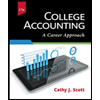
FIN.ACCT-TOOLS F/DECI.MAKERS-TEXT+WILEY+
9th Edition
ISBN: 9781119598312
Author: Kimmel
Publisher: WILEY C
expand_more
expand_more
format_list_bulleted
Question
Chapter 3, Problem 3.20E
To determine
Trial balance is the list of accounts and their debit and credit balances at a given time. It is usually prepared at end of the accounting period. Debit balances are listed in left column and credit balances are listed in right column. The totals of debit and credit column should be equal. Trial balance is useful in the preparation of the financial statements.
Balancing of trial balance:
Trial balance may balance even when any of the following errors occurs:
- 1) a transaction is not journalized,
- 2) a correct
journal entry is not posted in the ledger, - 3) a journal entry is posted twice,
- 4) incorrect accounts are used in journalizing or posting, or
- 5) Compensating errors are made in recording the amount of a transaction.
To analyze: the errors made by book keeper and their effect in trial balance.
Expert Solution & Answer
Want to see the full answer?
Check out a sample textbook solution
Students have asked these similar questions
I need help finding the accurate solution to this general accounting problem with valid methods.
General accounting question
Can you help me solve this general accounting problem with the correct methodology?
Chapter 3 Solutions
FIN.ACCT-TOOLS F/DECI.MAKERS-TEXT+WILEY+
Ch. 3 - Prob. 1QCh. 3 - Can a business enter into a transaction that...Ch. 3 - Are the followingevents recorded in the accounting...Ch. 3 - Prob. 4QCh. 3 - Prob. 5QCh. 3 - Prob. 6QCh. 3 - Prob. 7QCh. 3 - Misty Reno, a beginning accounting student,...Ch. 3 - Prob. 9QCh. 3 - What is the normal balance for each of these...
Ch. 3 - Prob. 11QCh. 3 - Prob. 12QCh. 3 - Prob. 13QCh. 3 - Prob. 14QCh. 3 - Prob. 15QCh. 3 - (a) When entering a transaction in the journal,...Ch. 3 - (a) Should accounting transaction debits and...Ch. 3 - Journalize these accounting transactions. (a)...Ch. 3 - Prob. 19QCh. 3 - Prob. 20QCh. 3 - Prob. 21QCh. 3 - Prob. 22QCh. 3 - Prob. 3.1BECh. 3 - For each of the following accounts, indicate the...Ch. 3 - Prob. 3.6BECh. 3 - Prob. 3.7BECh. 3 - Prob. 3.9BECh. 3 - Tilton Corporation has the following transactions...Ch. 3 - Prob. 3.11BECh. 3 - Selected transactions for Montes Company are...Ch. 3 - Prob. 3.1DIECh. 3 - Prob. 3.2DIECh. 3 - Prob. 3.3DIECh. 3 - Prob. 3.4DIECh. 3 - Prob. 3.1ECh. 3 - Prob. 3.6ECh. 3 - Prob. 3.7ECh. 3 - Prob. 3.8ECh. 3 - Prob. 3.9ECh. 3 - Prob. 3.10ECh. 3 - Prob. 3.11ECh. 3 - Prob. 3.12ECh. 3 - Prob. 3.15ECh. 3 - Prob. 3.20ECh. 3 - Prob. 3.23ECh. 3 - Prob. 3.1APCh. 3 - Prob. 3.4APCh. 3 - Prob. 3.11APCh. 3 - Prob. 3.2EYCTCh. 3 - Prob. 3.3EYCTCh. 3 - Prob. 3.4EYCTCh. 3 - Prob. 3.7EYCTCh. 3 - Prob. 3.8EYCTCh. 3 - Prob. 3.9EYCTCh. 3 - Prob. 3.11EYCTCh. 3 - Prob. 3.1IFRS
Knowledge Booster
Learn more about
Need a deep-dive on the concept behind this application? Look no further. Learn more about this topic, accounting and related others by exploring similar questions and additional content below.Similar questions
- help me this question solution pleasearrow_forwardPlease provide the solution to this financial accounting question using proper accounting principles.arrow_forwardBelow is information for Blue Company. Using this information, answer the following questions on the "Calculation" tab in the file. Show your work (how you got your answer) and format appropriately. Blue company has prepared the following contribution format income statement based on a sales volume of 1,000 units (the relevant range of production is 500 to 1,500 units): Sales $ 40,000 Variable expenses 24,000 Contribution margin 16,000 NOTE: Use the amounts in the original fact pattern to the left as your basis for the questions below. Fixed expenses 12,000 Net operating income $ 4,000 Questions: 1. What is the contribution margin per unit? 2. What is the contribution margin ratio? 3. What is…arrow_forward
- Robin Corporation has ordinary income from operations of $30,000, net long-term capital gain of $10,000, and net short-term capital loss of $15,000. What is the taxable income for 2010? a) $25,000. b) $27,000. c) $28,500. d) $30,000. e) None of the above.arrow_forwardPlease explain the solution to this financial accounting problem using the correct financial principles.arrow_forwardI need the correct answer to this financial accounting problem using the standard accounting approach.arrow_forward
arrow_back_ios
SEE MORE QUESTIONS
arrow_forward_ios
Recommended textbooks for you
 College Accounting (Book Only): A Career ApproachAccountingISBN:9781337280570Author:Scott, Cathy J.Publisher:South-Western College Pub
College Accounting (Book Only): A Career ApproachAccountingISBN:9781337280570Author:Scott, Cathy J.Publisher:South-Western College Pub Financial AccountingAccountingISBN:9781337272124Author:Carl Warren, James M. Reeve, Jonathan DuchacPublisher:Cengage LearningPrinciples of Accounting Volume 1AccountingISBN:9781947172685Author:OpenStaxPublisher:OpenStax College
Financial AccountingAccountingISBN:9781337272124Author:Carl Warren, James M. Reeve, Jonathan DuchacPublisher:Cengage LearningPrinciples of Accounting Volume 1AccountingISBN:9781947172685Author:OpenStaxPublisher:OpenStax College

College Accounting (Book Only): A Career Approach
Accounting
ISBN:9781337280570
Author:Scott, Cathy J.
Publisher:South-Western College Pub

Financial Accounting
Accounting
ISBN:9781337272124
Author:Carl Warren, James M. Reeve, Jonathan Duchac
Publisher:Cengage Learning

Principles of Accounting Volume 1
Accounting
ISBN:9781947172685
Author:OpenStax
Publisher:OpenStax College
Accounting Changes and Error Analysis: Intermediate Accounting Chapter 22; Author: Finally Learn;https://www.youtube.com/watch?v=c2uQdN53MV4;License: Standard Youtube License